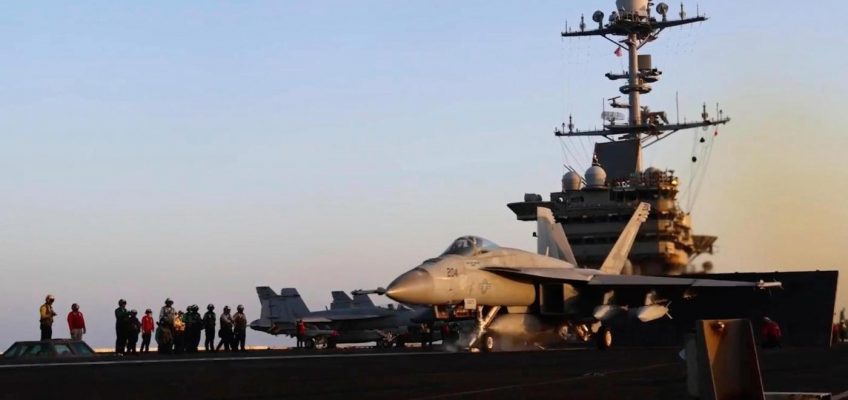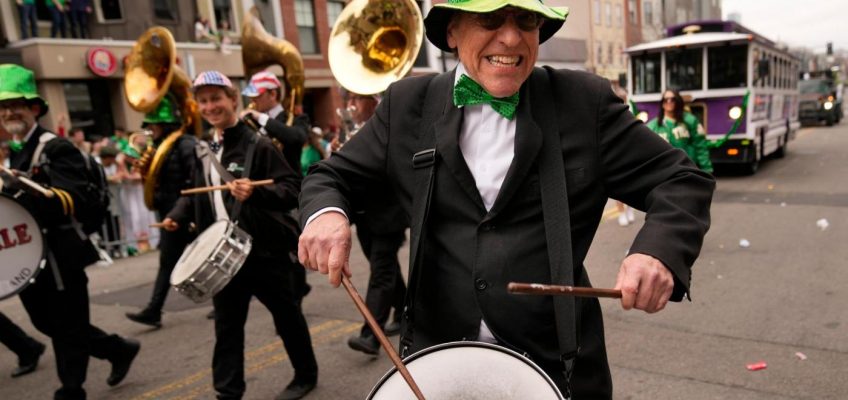In the movie The In Between, set in Eagle Pass, a group of five athletic high school boys jog down a dirt road. To their left is a thick brush of reeds that line the Rio Grande. To their right is the steel border wall, looming ominously.
“Hey, the Border Patrol, dude!” one says as a car approaches.
“He’s like, ‘What the heck?’” another says as they step aside to allow the unmistakable green-and-white pickup to pass.
Later, on the Mexican side, a group of elementary-aged boys sit on a branch overlooking the river. “How cool to get across,” one says in Spanish, “When you cross this bridge here, you can see turtles in the water.”
The Piedras Negras boys look to the sky in awe as a pair of military helicopters fly over, drowning out the sound of birds and insects. “So cool,” one says before they all jump into the river to swim.
After The In Between screened at the Vancouver International Film Festival in October, an audience member told director Roberta “Robie” Flores that these scenes had caused her to seize up, bracing herself for impending tragedy. To Flores’ surprise, another spectator had the same reaction in Mexico at the Morelia Film Festival.
For viewers from the border, scenes like these do not invoke the same tension or sense of dread. They depict a normal part of growing up here: in other words, not much. The high schoolers laugh and continue running. The younger kids swim until it’s time to go home.
“Isn’t it funny?” the audience member in Morelia asked Flores. “Our expectation of the border is so ingrained that the whole time I was just waiting for something bad to happen. And then it didn’t, and then you took us to a carne asada. I really needed that.”
For Flores, those reactions were gratifying. “That was so beautiful to hear because this is what we’re trying to do,” she said during my recent Zoom interview with her and her brother and producer Alex Flores. “Our plan worked.”
In stark contrast to dramatic border thrillers like Sicario, where a cartel shootout breaks out on the El Paso international bridge in broad daylight, boredom is often the worst-case scenario for people who actually live along the border, at least on the U.S. side. And a flurry of new films is now correcting the record.
A still image from The In Between of two
Eagle Pass teenagers after their high school
graduation (Courtesy/The In Between)
In Hummingbirds, a 2023 coming-of-age documentary, two college-aged girls pass the summer in Laredo, two hours downriver from Eagle Pass. They walk right up to the riverbank and wave at people fishing across the divide, who wave back. For co-director and co-star Estefania Contreras, who was born in Mexico but grew up in Laredo, her border crisis is trying to get a status update on her immigration application so she can work a summer job.
In Going Varsity in Mariachi, a 2023 documentary set in the Rio Grande Valley, a scene of an international bridge is as unremarkable as shots of palm-tree-lined streets typical of the area. Many viewers might not even consider the movie’s South Texas setting. Instead, they might focus on the universal high school experience of an underdog varsity team winning state, hugging, crying, graduating, then moving on.
These are just a few of the films traveling the festival circuit across the United States and beyond (Hummingbirds won a Grand Prix award at the Berlin International Film Festival). They often surprise audience members who come with a negative preconception of border stories.
In the vast, misunderstood region that straddles, in Texas, 1,254 miles from El Paso to the Gulf, creatives are taking control of their own stories. For people like Robie and Alex Flores, combating negative narratives is intentional. Others aren’t engaging directly in this fight, choosing to make horror flicks and stoner comedies. Some have worked in Los Angeles or Austin and are coming home. Others are resisting the old call to leave for brighter lights, staying put, and improvising with old camcorders and cell phones.
To many Americans, the southern edge of civilization lies somewhere in San Antonio (or even Austin). Long dismissed or disregarded, the Texas-Mexico border has come to be seen as a violent no-man’s-land thanks to incessant sensational news coverage and cartel thrillers. But, partly because of this cultural isolation, the region has also served as an incubator for creatives with unique “in between” experiences that defy the broad Latino tropes we see depicted on screen: the dusty roads, stray dogs, the abuelita lighting a candle to La Virgen, the overuse of words like “mija” in forced Spanglish.
Historically, a lack of creative outlets and infrastructure has caused many to leave the border for entertainment hubs like Los Angeles, New York, and Austin. Alfonso Gomez-Rejon, director of high-budget films Me and Earl and the Dying Girl (2015) and The Current War (2017), left Laredo for New York University (NYU) film school in the early 1990s. At the time, he didn’t appreciate the unique perspective he brought, instead coming to New York with a case of imposter syndrome, working alongside relatively more privileged students from places like Connecticut and California.
“I FELT SO GASLIT FROM MY ENTIRE EXPERIENCE BEING A BORDER CHILD.”
“I never wanted to get out of this place. I love Laredo and always have,” said Gomez-Rejon. “But I had no choice. This was pre-internet, when I needed access to film, film history, 61mm film, bolex. … In hindsight, I understand what I needed was exposure to a community that mirrored what my real life would look like as a professional filmmaker.”
Perhaps other than Austin, that kind of community has been largely nonexistent in Texas aside from limited audiovisual programs at high schools or colleges, where students might learn the fundamentals of camera work or editing but then be compelled to leave to actually earn a living.
This has now started to change because of a confluence of factors. An institutional decentralization, from Los Angeles to other film hubs, has allowed for a burgeoning filmmaking scene centered around locations including Atlanta and Austin. The internet has made it easier to edit or submit audition tapes from across the country. And, for a strong current of new filmmakers from the border, it was the 2016 election that sparked an acute urge to set the story straight about the region.
Flores, the director of The In Between, didn’t know that she wanted to engage in border narratives when she went to NYU to study journalism. This started to change when she was doing freelance video editing for Bloomberg in New York during Trump’s first rise to the White House.
“I would hear the sound bites [about the border] all day,” she said. “I thought, ‘Am I crazy?’ It’s such a chill place, but everyone on the news is making it sound like an action movie. I felt so gaslit from my entire experience being a border child.”
Her feeling is supported by objective data. Even as immigration ebbs and flows and political winds shift, Texas border cities are consistently among the safest in the nation.
“I was just so over it. I thought, ‘I’m just gonna have to make un chingo de películas fronterizas to flood the space of movies.’”
As any filmmaker knows, making even one movie is a daunting endeavor, much less chingos. The In Between, for instance, took about five years to reach final cut after a significant rework with the help of consultant Barbara Cigarroa, a Laredo native.
“Then we heard about Hummingbirds out of Laredo, and I was like ‘Are you kidding me, there’s more young people out there that are also doing a fun, whimsical story about how cute our experiences are on the border?!’” Flores said. “I want to be friends with these people.”
Flores and her brother fire off a list of recent border gems: Cristina Ibarra’s Las Marthas (2014), University of Texas at Austin film professor Iliana Sosa’s What we Leave Behind (2022) and her El Paso episode of God Save Texas (2024), Isabel Castro’s Mija (2022), Maisie Crow’s At the Ready (2021), and Aitch Alberto’s Aristotle and Dante Discover the Secrets to the Universe (2023).
“It felt like a comet, una estrella fugaz, that exploded at the same moment and all the little sparkles were our films that all just came out into the world at the same time,” Flores said. “It felt exciting and additive versus competitive because this is what we wanted, now we don’t have to do all these by ourselves, we can all make chingos of movies together.”
The movies listed by the Flores siblings have been referred to as the “Border New Wave.”And while these border-focused alternative narratives are certainly at the forefront of something new and exciting in film, they have also created space for filmmakers who defy categorization and don’t wish to engage in border narratives at all.
Long before Trump elevated the border’s national profile, there was a slow-burning distaste among Latinos for being flattened into one monolithic group with a simplified storyline. Accurate representation is still lacking even 30 years after Selena, one of the first major Hollywood films to address the “in between” Tejano predicament. Emila Perez, for instance, just won Best Picture at the Golden Globes despite wide criticism that it misrepresents both the Latino and trans experience. Just when we thought we had overcome Penelope Cruz’s spicy hysterical Latina caricature in Blow (2001), Selena Gomez’s character in Emilia Perez strangely speaks an awkward Spanglish despite purportedly playing a Mexican narco wife.
According to James Rodriguez, who founded the Austin nonprofit Saint Primo last year to empower Latinos in filmmaking, “If you look at the film industry as a whole, Latinos make up less than 6 percent in front of the camera, and less than 4 percent behind the camera, and we’re making [up] at least 30 percent of the population and growing.”
Traditionally, studios simply weren’t interested in nuanced Latino voices, which sometimes limited the subject matter that filmmakers were able to cover as they tried to pave their way in a competitive industry. “You’re trying to reach as big an audience as you can to be marketable because there just isn’t enough work right now,” said Paco Farias, an Eagle Pass native and screenwriter, citing a seismic shift after the writer and actor strikes in 2023 as streaming companies reevaluate their profit models.
Farias wrote the screenplay for The Long Game, the true story of a Latino golf coach and his high school team trying to earn their way into playing at the segregated Del Rio Country Club. The movie depicts an older Latino generation of the 1950s, when near-total assimilation was the only way to get ahead. The same has gone for film, in which adhering to broad Hollywood narratives was necessary to compete.
The recent shift in attitudes has been largely driven at the grassroots level by persistent pressure from filmmakers and advocacy groups. Many of these creatives have found community and support with organizations like the Laredo Film Society (LFS)—of which I am a board member—founded by Gabriela Treviño, Karen Gaytán, and Lizette Montiel in 2018. Treviño works for Borderlands Studios, which aims to improve Latino representation. She credits her filmmaking journey to inspiration from programs like a film camp for kids called Hecho en Encinal just north of Laredo, as well as mentorship by the camp’s director Marcela Moran, a film professor at Texas A&M International University whom many local filmmakers credit with their first introduction to film.
“I realized how many resources we actually have in Laredo compared to Encinal (population 500), where there’s not a university or even a high school,” Treviño said. Later, after an internship with the 40-year-old Austin Film Society, she used her experience to apply that nonprofit’s model to Laredo.
Treviño and Gaytán are both members of a loose network of filmmakers dubbed the Bordertown Film Collective. Gaytán is currently directing a documentary about the boxer Jenny “Traviesa” Lozano, Laredo’s first-ever olympian who just competed in Paris, and she recently won an Emmy for producing the National Geographic documentary The Science Fair. Neither of these films are “border stories” per se.
“I hope my work shows that culture transcends borders and that these arbitrary lines create such harmful policies,” said Gaytán. “I don’t think even people from the border realize how the ‘border problem’ impacts our way of life,” she added, noting how the crisis narrative detracts from real problems like water insecurity and some of the highest incidences of health problems like Alzheimer’s and diabetes.
Farther downriver, in Harlingen, the Entre Film Center is on a similar mission. In addition to community screenings and workshops, Entre recently launched Boca Chica Corazón Grande, which is documenting memories of the local beach under imminent threat from Elon Musk’s SpaceX.
Fred Elmes (left) and Alfonso Gomez-Rejon in Laredo at a cinematography master class in June 2023 (Courtesy/Jessica Rodriguez)
Andres Sanchez, who runs Entre along with C. Diaz and Monica Sosa (all hailing from different parts of the Rio Grande Valley), cites Entre’s mantra: “A post-border world is possible.” He explained the collective’s mission as prioritizing joy. “If you’re thinking about revolution, you work all day, and then you play a little bit. We want to be a space for people to play.”
There’s no doubt that Texas fronterizos have the talent and drive to tell their own stories.But film, in particular, requires significant investment and personnel, not to mention a distribution apparatus to make sure the work is actually seen.
Each person interviewed for this article cited a continuing lack of infrastructure that impedes film projects along the border. While these issues are prevalent across the entire state, they are acutely felt in South Texas.
Gomez-Rejon referenced Texas’s uncompetitive rebates and incentives, known as “soft money,” which causes the state to lose projects to neighboring New Mexico, Oklahoma, or Mexico. “I keep pushing Texas. … I have two films that I want to shoot in Texas and they immediately want to move it to New Mexico or Mexico City because it’s cheaper and there’s more of a rebate,” he said.
Texas recently spent a historic amount on its film rebate program, $200 million for the last biennium, yet is still losing projects to other states. During a legislative hearing last year, Texas film professionals including Taylor Sheridan and Dennis Quaid urged lawmakers to make the program more competitive. Sheridan noted that Hell or High Water, a modern cops-and-robbers western that could not be more in-your-face Texan, was shot in New Mexico. Lieutenant Governor Dan Patrick tasked the Senate Finance Committee to evaluate the costs and benefits of the program to see how it could be improved.
In South Texas, filmmakers experience challenges in obtaining permits for locations and scouting for talent, something that local film commissions or Film Friendly state certifications can help with (currently, only a handful of cities have these designations south of San Antonio). Brownsville has the region’s only film commission, which helped facilitate the filming of A Night in Old Mexico (2013) starring Robert Duval. Though the movie was set in Mexico, it was shot in downtown Brownsville, another benefit of historic border towns for crews wary of filming in Mexico.
As a testament to border improvisation, local groups are leading the charge in building the much-needed infrastructure. RR Cinematic, run by Laredo-based filmmakers Robert Ramirez and Robert Castañeda, recently partnered with LFS for a vampire-themed month of film, including a short film competition, reflecting Laredoans’ preference for horror over traditional border stories. RR just launched an acting workshop to support local productions, including their new feature in pre-production (which they describe to me as a horror musical).
Last year, Gomez-Rejon brought down Fred Elmes, the cinematographer of David Lynch’s iconic Blue Velvet, for a master class that attracted a packed house at the Laredo Center for the Arts.
“There was a kid that came up to me during the workshop, and he said something along the lines of, ‘I’m so surprised that Elmes would want to come to our hometown,’ as if they didn’t deserve that kind of access because of where we are,” Gomez-Rejon said. “My response is that this background is your secret weapon, this is what makes you unique, you deserve this, and you deserve a lot more.”
The post The Texas Border Is the New Frontier of Film appeared first on The Texas Observer.




